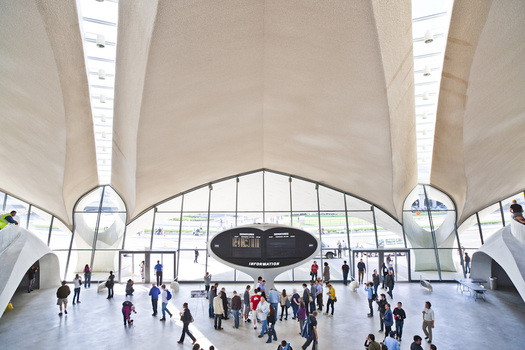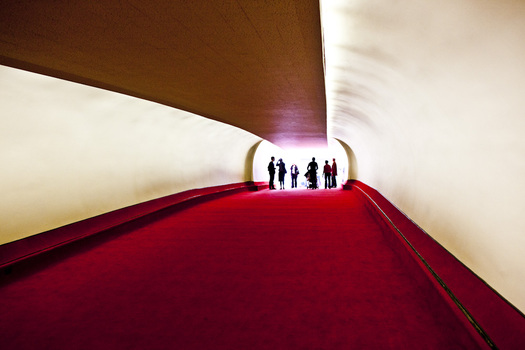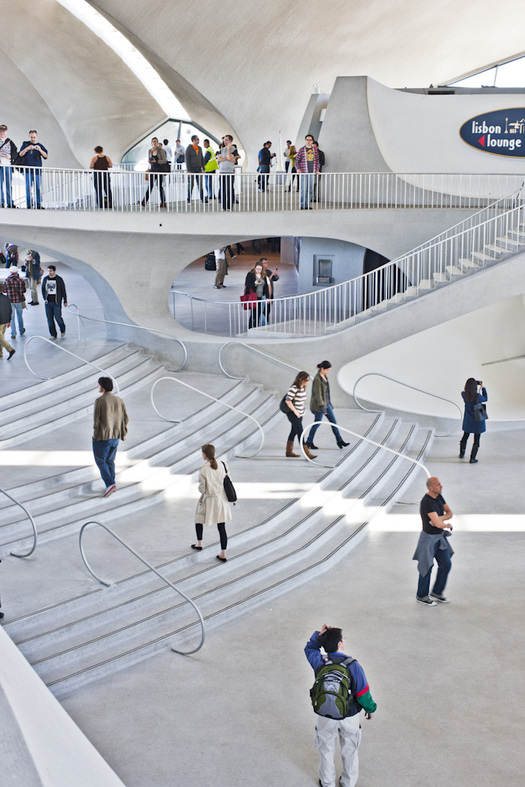
TWA Flight Center, Eero Saarinen & Associates (1962). All photos by Nicolas Lemery Nantel | salokin.com
The line of photographers started at the parking lot, setting up tripods in the thick, green grass at the edge. More occupied the median, and still more crowded the interior, blocking the delicate, cantilevered bridge so that few could pass. And yet, it was not a disappointment. The traffic still flowed. A few cars on the underutilized roadway in front. A mass around the information desk, drawn there despite there being no need for flight information. Steady streams up the shallow steps. And then, dispersion. Up the stairs to the Lisbon Lounge and the Paris Cafe, stripped to their chrome light fixtures and glazed tiles. Down the stairs to the red ilets of seating, facing another iris of information. Behind the iris: an expanse of gray gravel, and the dull curve of the JetBlue terminal. Where once there was a view of flight, now there is just a wall, and not even one activated, as the lifted wings are here, by the movement of people. Beyond the lounge, two tubes with violent red carpet and a wash of white light. No one seemed to be able to decide on the proper pace. Kids ran. Adults strolled. More photographers blocked the opening. And again a disappointing end. An elevator. A staircase. No planes in sight.
Various catalogs of the past. Filing cabinets next to the baggage carousels. Antique Merit cigarettes at luscious angles in the duty free cases. Travelex. Covetable typography on the sign for paper towels. A curvaceous shoeshine stand paved in the same tiny white tiles as the floors, stairs, walls. Another club where I feel the ghost of Warren Platner: a symphony in mauve, golden domes, big banquettes and tiny tulip tables.

On Sunday, a thousand people visited the TWA Flight Center as part of Open House New York's annual invitation to urban exploration. TWA was a last-minute and high-profile addition to the roster of open sites. I've been writing about Saarinen for ten years, and I'd never been able to do more than drive by. So I was thankful to be able to visit, and still more thankful that the building doesn't feel dead yet. Shored up by renovations by Beyer Blinder Belle (NewYorkology has a good summary), it is battered but the bones are still there. It has a limpid atmosphere, strangely relaxing. Once you are in, you can see everything. You have options: up, down, across. You would have had varying speeds: walking, running, taxiing, flying.
Saarinen's modernist iconoclasm was not just in the bird-like shape, so obvious to my four-year-old that he spent most of the visit searching for the eyes, the legs, the beak to go with the outspread wings. It is also in the building's pure, Beaux Arts symmetry. Those stone staircases were made for the sweep of a long gown, not the bump of wheelie suitcases. Even without the photographers, moving across the white slopes feels like a film trick, one in which you (the star!) are still and the scenery flows around you. Saarinen also accomplished the neat trick of putting the services on the inside, in dark areas that the French would have called poche. Today's airports put the people in the middle, away from the light and any sense of exterior orientation. The bulk is given over to ticketing and security, baggage and shops, so that people get only a narrow path. It's the opposite at TWA: the perimeter is for humans.

Now that we have seen it and loved it, what's next? No one seems to know. An RFP to build a new hotel on the expanse of gravel has taken a suspiciously long time to come to a result. The obvious use is as for pure hospitality, a bar and a lounge and a restaurant, a destination in itself. On Sunday, even with all those people, I wished I had brought lunch and could just sit. There's some talk that the Port Authority will (at least) open it for more regular tours. I can't see how a hotel in that location won't loom (TWA already looks mighty petite) but the damage in terms of the back view has already been done. The terminal needs a replacement for the view of flight, a big movie screen showing the moving machines Saarinen designing the terminal to showcase.
We don't want TWA to become just a bauble, a nostalgia museum. The best way to preserve something beautiful is to make it part of our world. Developers and their architects need to figure out a way to do that. Now.
